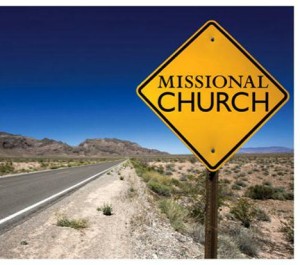A Missional Church?
Dearly Beloved,
In your email or US mail this week, you received a pastoral letter which makes very real the movement of our congregation towards a bold decision for the future. Please take the time to read it carefully and thoroughly as it describes where we are and what we are asking of you over the next month (or so) as we move thoughtfully and carefully towards our future.
I found that the most significant moments in our Crossroads conversations were those spend in imagining a future as a mission oriented faith community. I encourage you to consider the following excerpts about The Missional Church from Session IV. I pray that laid side by side with the Pastoral Letter you have received, you will be left with the same sense of hopefulness and future that I am experiencing in our midst as we birth a new call and mission for our ministry.
From Handout 4:1: The Missional Church, Part 2
In order to go into the world to live God’s mission—to establish relationships with people…congregations must know the needs, ways, language, and lifestyles of the “field of mis sion” which surrounds it…. And yet, increasingly, many congregations are cut off from their communities….
It’s very common for aging congregations to perpetuate old models of church-life. It’s also common for church activities to become self-focused – meeting only the social needs of congregational members without devoting sufficient energy for helping people live out their Christian calling to serve the larger world. To make matters worse, many congregations have few financial resources to engage in mission in their communities and world because they are spending larger portions of their budget on rising health care costs for their pastors and costly maintenance on their buildings.
Some of these congregations fall into the trap of survivalism, focusing more and more of their energies (and financial resource) on just keeping the church open. Likewise, less and less time, energy and resources are available to be active in meeting the ministry needs of the larger community and world.
Other congregations realize that simply tweaking worship services and patching up old buildings won’t really help the effort to redevelop ministry. Yet, they don’t have models for church life that go beyond what is called an attractional model of church life. Attractional models for congregational life are founded on the premise that a building with good Christian programming and strong worship will “attract” people to it. In this attractional model, there is a ceaseless quest for better programming, more relevant worship, more advertising and larger budgets. In fact, in North American culture, this model has served many churches well until the last decade or so. In a few places, this attractional model can still work. But it is based on the idea that people should “come to” church and that the church’s purpose is to serve its members and participants.
In the “missional” model of church that we explored in the previous session, the church is not a “come to” place but a “go to” lifestyle. In this model, the people of the church are constantly following God in mission to the world. Yes, the church gathers for worship and discipleship, but it is primarily focused on equipping people to live a Jesus lifestyle amid their daily lives.
Reggie McNeal, in his book, Missional Renaissance, says, “The missional church is an expression of God’s heart. It serves as an indication of God’s continuing commitment to God’s redemptive mission in the world….the missional church believes that God is on a mission and that we are to join God in that mission…not to ‘do church’ but to ‘be church.’ Missional is a way of living, not an affiliation or activity.” Missional churches are making three major shifts:
The shift from making good church members to making disciples of Jesus: This places a congregation’s focus on discipleship (living the lifestyle of Jesus) and challenges the often-held assumption that a church is a vendor of religious goods and services. We, as church participants, are not religious consumers, but children of God who need one another to train and coach us in how to live our daily lives.
The shift from church growth to community transformation: This moves us beyond the “Three B’s of traditional church: Buildings, Budgets and Behinds in the Seats!” Instead of having church growth as our goal, our goal is changing our neighborhood or city. Growth may happen, but it is a means to the end…not the end itself. With this shift, we see other local churches as partners in mission, not our “competition.”
The shift from preserving the institution to sending local missionaries: With this shift, we invest our congregation’s time and resources into equipping and encouraging people to deal with the daily stresses, challenges, relationships and activities of life. Instead of “guilting” people to serve on another committee or attend more church meetings, we free them to live the Jesus lifestyle in their personal routines. People are encouraged to be involved with civic gr oups, youth sports, schools, politics, workplace activities and to “infect” those areas of community life with the values of the Gospel.
oups, youth sports, schools, politics, workplace activities and to “infect” those areas of community life with the values of the Gospel.
So what about you? Are you ready to make this shift? Are you ready to be God’s hands, God’s feet, God’s very own heart?
I know I am!
Rev. Wendy Miller Olapade, revwdmiller@comcast.net
